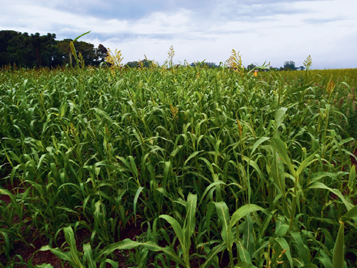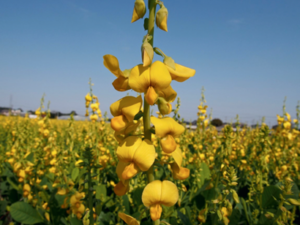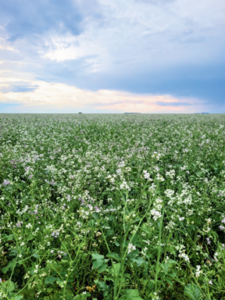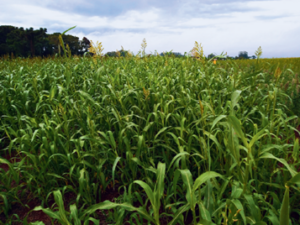The adoption of cover crops can improve soil health, increase productivity, and strengthen agriculture’s resilience to climate change
Cover crops are crops with the purpose of improving soil health, protecting against erosion, and increasing the resilience of agricultural systems. In the context of climate change and the need for greater sustainability, these plants play a fundamental role in mitigating the environmental impacts of agriculture. In addition to promoting the diversification of production systems, they help conserve natural resources and strengthen crop stability under adverse conditions.
The adoption of cover crops has been recognized as an effective strategy for restoring soil fertility and promoting essential ecosystem services. They enhance soil carbon retention, improve soil structure, and contribute to the biological control of pests and diseases. In tropical regions, there is a wide variety of adapted species that can be grown individually or in intercropping systems, maximizing both agronomic and environmental benefits.
Want to learn how cover crops can transform agriculture and increase crop resilience in the face of climate change? Keep reading to discover the benefits and best strategies for integrating them into a productive system!
Benefits of Introducing Cover Crops into Production Systems
Among the main benefits of cover crops for agricultural production, we can highlight:
Soil Fertility Management
The use of cover crops significantly contributes to increasing soil organic matter, which enhances nutrient cycling and carbon storage. This increase in plant biomass improves the availability of essential nutrients for subsequent crops, such as nitrogen, phosphorus, and potassium. Additionally, legumes promote biological nitrogen fixation that can reduce the need for chemical fertilizers, while non-leguminous plants help minimize nitrate leaching.
Weed Management
Cover crops play a fundamental role in weed control. They compete for light, water, and nutrients, limiting weed growth. Additionally, some types of cover crops have an allelopathic effect, releasing substances that inhibit the germination of unwanted seeds. Cover crops also act as physical barriers, making it more difficult for invasive plants to emerge from the soil.
Soil and Water Conservation
Cover crops help in soil conservation by protecting it from erosion caused by water and wind. The vegetation reduces the impact of rainfall and increases soil roughness, which decreases surface runoff and improves water infiltration. Additionally, they regulate soil temperature and reduce evaporation, contributing to better water retention in the soil. This is essential during periods of prolonged droughts. The presence of roots also improves soil structure, favoring the formation of biopores that increase water retention and air flow in the soil.
Biodiversity Promotion
The use of cover crops significantly contributes to increasing biodiversity in the soil and agricultural landscape. These plants provide shelter and food for a wide variety of beneficial organisms, such as microorganisms, predatory insects, and pollinators, while also helping maintain natural enemies of pests. Plant diversity in the soil also supports the presence of different microbial groups, enhancing nutrient cycling and pathogen suppression. As a result, the introduction of cover crops strengthens ecological balance, promoting more resilient and productive agricultural systems.
Increase in Organic Matter and Carbon Sequestration
Cover crops significantly contribute to increasing soil organic matter, promoting long-term improvements in soil structure and fertility. The biomass produced by these plants, when incorporated into the soil, increases organic carbon content, enhancing microbial activity and the formation of stable aggregates. Additionally, cover crops play a crucial role in atmospheric carbon sequestration, helping to mitigate climate change. This process reduces the environmental impact of agriculture while simultaneously improving soil health and productivity.
Types of Cover Crops
Selecting the ideal cover crop for a given area requires a careful analysis of soil needs and local climate conditions. Below are some categories of cover crops and their main benefits:
Legumes: Nitrogen Supply
Legumes are excellent nitrogen fixers, reducing the need for synthetic fertilizers. Species such as sunn hemp, forage peanut, vetch, and clover help enrich the soil, improving its fertility and structure. They are especially recommended for soils with low nitrogen availability and for systems aiming for greater sustainability.
Crotalaria spectabilis (Photo by Larissa Bortolo)
Grasses: Soil Protection and Organic Matter
Grasses, such as millet, oats, and brachiaria, are highly effective in biomass production, contributing to the addition of organic matter and the improvement of soil structure. They help retain moisture, reduce compaction, and control erosion, making them ideal for areas with fragile or sloped soils.
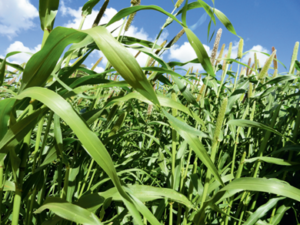 Millet – Pennisetum glaucum (Photo by Piraí Sementes)
Millet – Pennisetum glaucum (Photo by Piraí Sementes)
Crucifers: Nutrient Recycling
Plants such as forage radish and mustard have deep roots that break up compacted soil layers and aid in nutrient cycling. They promote the uptake of essential elements by subsequent crops, optimizing the use of available natural resources.
Forage radish – Raphanus sativus (Photo by Viviana Meneghini)
Drought-Tolerant Species: Adaptation to Arid Climates
In regions with irregular rainfall, it is essential to choose species adapted to water scarcity. Some options include forage sorghum and pigeon pea, which can withstand prolonged drought periods while continuing to provide ground cover.
Forage sorghum – Sorghum bicolor (Photo by Ana Paula Maccari)
Management of Cover Crops
To maximize the beneficial effects of cover crops, proper management is essential. This involves everything from choosing the species to how they are implemented and intercropped with economically important crops. Below, we present the main aspects of cover crop management.
Growing Season
The choice of growing season is crucial for the success of cover crops. In Brazil, there are two main planting windows: spring-summer and late summer to winter. In some regions, cultivation is possible in the winter-spring period. However, climatic factors, such as water scarcity in the Cerrado and low temperatures in the South, impact species selection.
Intercropping with Commercial Crops
To optimize the use of available resources, cover crops are often intercropped with economically important crops, such as corn and soybeans. This intercropping can occur simultaneously or at different times during the main crop’s cycle, depending on the competitive potential of each species.
Seeding Methods
Seeding can be done in rows or broadcast, and the choice of method depends on the area conditions and the objective of the cover crop. Row seeding provides greater uniformity and better nutrient utilization, while broadcast seeding is faster and more feasible for large areas.
Cover Crop Mixes
The use of different species in the same system, known as a cover crop mix, promotes a more comprehensive approach to improving the soil. The combination of species with different functions, such as nitrogen fixation, vigorous root growth, and high biomass production, ensures a more efficient use of resources.
Management of Tiguera and Weeds
A critical factor for the success of cover crops is the control of tiguera (volunteer plants from previous crops) and weeds. Cultural methods, such as crop rotation and the suppressive effect of cover crops, are effective strategies. Mechanical and chemical management may also be necessary to prevent competition and the spread of pests and diseases.
Cover Crops: Recent Advances and Their Impact on Sustainability and Climate Resilience
Researchers from CCARBON/USP and other partner institutions have demonstrated how the diversification of agricultural systems with cover crops can improve soil health, increase productivity, and make crops more resilient to climate stress. The study, conducted over five years in the Cerrado biome, evaluated the impact of different soybean succession systems, comparing the use of cover crops and corn as a second crop. Eight soil health indicators were analyzed, including organic carbon, aggregate stability, and soil density, in addition to soybean productivity to correlate soil health with yield and crop resilience.
The results showed that the use of cover crop mixtures and brachiaria after soybeans significantly improved the biological indicators of the soil, increasing productivity and reducing yield variability in response to climate. The study indicated that healthier soils were directly linked to greater stability in production, with β-glucosidase activity explaining 35% of soybean resilience to climate stress. These findings highlight the potential of cover crops in building more sustainable, productive, and adaptable agricultural systems in the face of climate change, particularly in tropical regions such as Brazil.
Challenges of Using Cover Crops
The use of cover crops brings numerous benefits but also faces challenges that must be considered for their efficient implementation. One of the main obstacles is related to the proper management of these plants, which can vary depending on climatic and regional conditions. Factors such as soil type, water availability, and the main crop influence the choice of the most appropriate species. Additionally, competition for nutrients can negatively impact the development of commercial crops.
Another important challenge is the interaction between cover crops and pests or diseases. While many species are effective in interrupting pathogen cycles, some may act as hosts for pests and diseases that affect commercial crops. This emphasizes the need for proper phytosanitary management, including the adoption of sanitary fallow to prevent the proliferation of pests and diseases. Moreover, the improper selection of cover crop species can result in agronomic issues, such as competition for water during drought periods. Therefore, the success of using cover crops depends on careful planning and the selection of appropriate species for each region and production system.
Final Considerations
Cover crops play a crucial role in climate change adaptation and mitigation. They contribute to carbon sequestration, increase soil organic matter, improve moisture retention, and reduce erosion, making agricultural systems more resilient to extreme weather events. However, to maximize these benefits and minimize negative impacts, it is essential to invest in ongoing research to refine the management of species and their adaptation to varying climatic and productive conditions.
To learn more about this topic, check out the “Guia prático de plantas de cobertura: espécies, manejo e impacto na saúde do solo” and explore the main cover crops cultivated in Brazil.
______________________________________________________________________
See also:
Regenerative Agriculture: the path to sustainable production
______________________________________________________________________
Main sources:
CHERUBIN, Maurício Roberto. et al. Guia prático de plantas de cobertura: espécies, manejo e impacto na saúde do solo. Universidade de São Paulo. Escola Superior de Agricultura Luiz de Queiroz, 2024. DOI: https://doi.org/10.11606/9786587391618 Disponível em: www.livrosabertos.abcd.usp.br/portaldelivrosUSP/catalog/book/1340 . Acesso em 12 março. 2025.
Souza, V.S.; Canisares, L.P.; Schiebelbein, B.E.; Santos, D.C.; Menillo, R.M.; Pinheiro Junior, C.R.; Cherubin, M.R. Cover crops enhance soil health, crop yield and resilience of tropical agroecosystem, Field Crops Research, Volume 322, 109755, 2025 https://doi.org/10.1016/j.fcr.2025.109755

